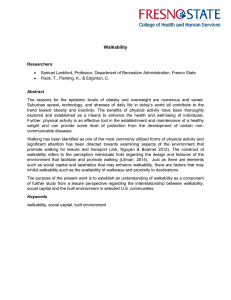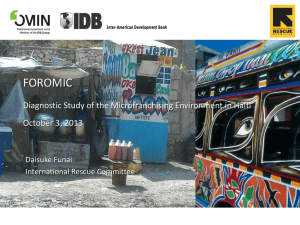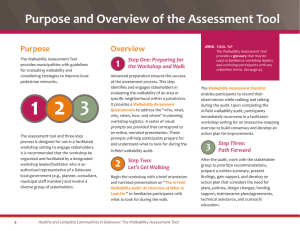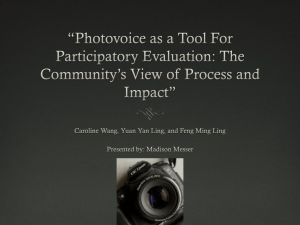Community Health Assessment aNd Group Evaluation
advertisement
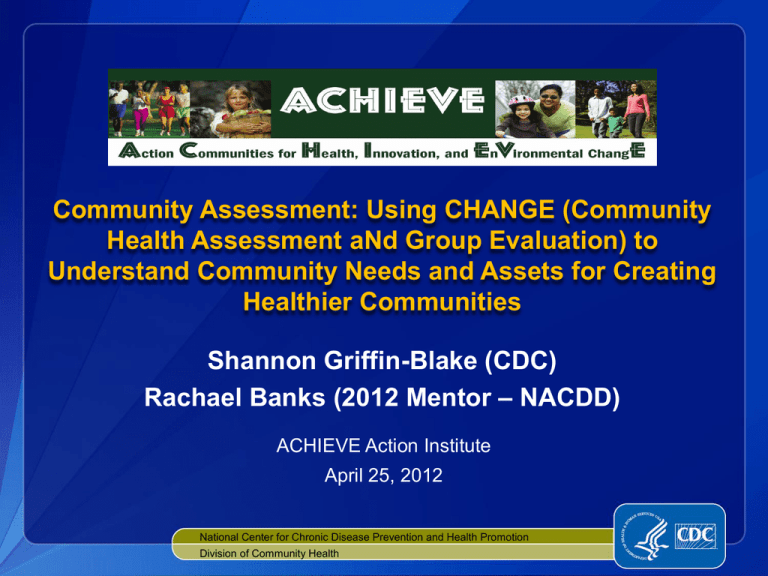
Community Assessment: Using CHANGE (Community Health Assessment aNd Group Evaluation) to Understand Community Needs and Assets for Creating Healthier Communities Shannon Griffin-Blake (CDC) Rachael Banks (2012 Mentor – NACDD) ACHIEVE Action Institute April 25, 2012 National Center for Chronic Disease Prevention and Health Promotion Division of Community Health Community Assessment: Using CHANGE (Community Health Assessment aNd Group Evaluation) to Understand Community Needs and Assets for Creating Healthier Communities Shannon Griffin-Blake, PhD Acting Director, CDC’s Healthy Communities Program (HCP) Program Services and Evaluation Team Lead, HCP Division of Community Health Community Health Assessment aNd Group Evaluation (CHANGE) Background: Can assessment be a useful part of ACHIEVE process? How does local-level data assist you in your work? What is the value of assessing population-based strategies? How can CHANGE help inform your ACHIEVE efforts? CHANGE Action Guide: Step-by-step process Rachael Banks: 2012 Mentor - Oregon ACHIEVE PROCESS COMMITMENT ASSESSMENT PLANNING IMPLEMENTATION EVALUATE • CHART development & joint ownership • Capture community snapshot (local-level data) • Prioritize targeted action • Population-based strategies • Document success ACHIEVE Program Why are we here? ACHIEVE’ing Multi-level Impact: • • • • • Creating healthy environments Developing community support Influencing social norms Facilitating healthy behaviors Implementing high impact strategies Why Population-Based Strategies? • Build on lessons learned • Want to see communitylevel change • More sustainable • Make the healthy choice, the easy choice! Emerging Vision >>>>>> >>>>>> Existing Initiatives CHANGE Setting Priorities (Community Action Plan) Local Trends Community Assessment ACHIEVE Process: Assessment What is a community assessment? An examination of a community’s current assets, needs, resources, strengths, and challenges. • Document community resources, infrastructures, relationships, and operations • Identify potential areas for targeted action • Build CHART consensus • Strengthen team cohesion ACHIEVE Process: Assessment Why are community assessments important? • Consider existing community strengths that can be mobilized • Identify gaps or areas for improvement • Assist in making decisions about where to focus resources and interventions in order to maximally benefit the community • Guide where CHART starts: Develop a common understanding and determine what factors are needed in order to track or monitor change • Provide community ‘voice’ or insight into community context Why complete a community assessment? “A community assessment process is not just a matter of surveying what people need, but it is a community organizing strategy. By rigorously and creatively assessing community needs, the process gives real ‘voice’ to individuals in the community…voices that can significantly influence program design.” Source: Chang, H. Drawing Strength from Diversity: Effective Services for Children, Youth, and Families. Los Angeles: California Tomorrow; 1994. ACHIEVE Process: Assessment How to complete a community assessment? • Use as CHART activity • Operationalize CHART principles • Create information sharing across team members • Solidify decision-making • Create community engagement and ownership Community Health Assessment aNd Group Evaluation (CHANGE) CHANGE Tool Purposes: 1) Capture current snapshot of the community 2) Group activity/consensus building CHANGE: Overview • Frame and understand the current status of community health • Provides a snapshot of policy, systems, and environmental strategies (‘assets’ and ‘needs’) • Move the community towards sustainable change • Allows communities to track progress across a 5-point scale so incremental changes can be noted • Prioritize community needs and consider appropriate allocation of resources • Used annually to assess current strategies, chart progress and offer new priorities CHANGE: Gathering Local-Level Data • Establish baseline or starting point for ACHIEVE efforts • Provide direct input to decision-makers about community needs • Inform prioritization for Community Action Plan (CAP) development • Can use annually for multiple observations to monitor and track progress • Prepare for future opportunities CHANGE: Benefits What have we learned… • • ‘helped coalition members get involved • early’ • ‘helped explained policy’ • • ‘changed how people think about policy’ ‘surprised by results’ ‘did not realize how important data can be for us’ ‘uncovered other assessments in my community we could tap into’ Rachael Banks Multnomah County Health Department ACHIEVE Mentor Coach CHANGE: Local Experience Why CHANGE is Awesome! • Framework to build on existing data • Way to engage community and CHART • Policy-focus, organizational changes • Baseline and track progress • Starts community conversation of success Multnomah County CHANGE Story: – CHART formed due to health disparities data – Gathered existing reports, focus groups and coalitions – Compiled data and prioritized next steps to assess policy Quotes from CHART “I kept engaged because I appreciated that upfront work was completed. The coaches honored the work already done without assuming we knew everything” -CHART member Way to Honor Community Wisdom • Community Engagement – CHART can prioritize sites – CHART can conduct assessments • Observations in settings • Windshield tours • Focus groups – CHART can summarize findings Data Along-Side Stories Value of Policy Perspective • Way to approach conversations with stakeholders • Asks questions that raises awareness of importance of environment • Provides range of options • Tracks progress of policies over time Shows Where You Are, Where You Can Be You Can Do It! • Utilize expertise of CHART • Engage local community • Use national resources • Have fun, do more • Build your legacy… and document it CHANGE Action Guide Topics covered: 1. Data Collection (pages 1318) 2. Organizing and Using CHANGE Data (pages 3238) 3. Developing and Revising Your CAP (pages 39-40) 4. Evaluation and Reassessment (pages 4344) 5. CD-ROM: Resource List, Blank Worksheets, CHANGE Sector Excel Files Website: http://www.cdc.gov/HealthyCommunitiesProgram CHANGE Action Guide CHANGE Action Guide proposes 8 step process Step 1: Assemble Community Team CHARTs with broad participation from community leaders: Step 2: Develop Team Strategy Deciding on how best to complete CHANGE sectors or sites: 1. Whole team 2. Splinter into smaller groups (2 or more members) Step 3: Review 5 CHANGE Sectors CHANGE Tool 5 Sectors -Community-At-Large: Includes community-wide efforts that impact the social and built environments, such as food access, walkability or bikeability, smoking bans, and personal safety. Places for assessment: Grocery store, restaurant, media, city/county government, community garden, neighborhood, park, downtown center, retail establishment/outlet, health department, police/sheriff department CHANGE Tool 5 Sectors -- Community Institution/Organization (CIO): Includes entities within the community that provide a broad range of human services and access to facilities Sites for assessment: Child care facility, faith-based institution (e.g., church, synagogue, mosque), YMCA, senior center, health and wellness organization, and college or university CHANGE Tool 5 Sectors -- Health Care: Includes places people go to receive preventive care or treatment, or emergency health care services Sites for assessment: Hospital, health department, private practitioner’s office, health maintenance organization (HMO), home health agency, or community clinic CHANGE Tool 5 Sectors -School: Includes all primary and secondary learning institutions Sites for assessment: Elementary, middle and high school (whether private, public, charter, or parochial) CHANGE Tool 5 Sectors -Work Site: Includes places of employment Sites for assessment: Private office, school, textile factory, restaurant, retail establishment/outlet, bank, health department, post office, or manufacturing company ACHIEVE: CHANGE Completion • CHANGE Completion: Community-At-Large Sector and minimum of 1 additional sector • Minimum of 3 sites per additional sector Step 4: Gather Data Determine what information you need to collect to better understand your community…and complete CHANGE. Example Methods: • Survey data • Community dialogue • Photovoice • Community audit and observation Data Collection: Example Methods Community-At-Large Sector: • Face-to-Face Survey* • Observation: Windshield Survey & Checklist • Photovoice • Walkability Audit • Media Review Community Institution/Organization Sector: • Focus group • Historical document review • Walkability Audit Health Care Sector • Focus Group • Observation: Checklist School Sector: • Walkability Audit • Photovoice • Observation: PTA Meetings • Historical document review Work Site Sector: • Focus Group • Historical document review Photovoice Community Strengths/Resources Community Commons (Beta 2.0): Released March 13, 2012 New Starter Maps & Tutorials • With a few clicks, you can create compelling interactive maps to tell your community story • Useful tool for both those new to GIS and those experienced with mapping Available at: http://communityhealth.hhs.gov CHANGE Action Guide CHANGE Action Guide proposes 8 step process CHANGE Webinar: March 13, 2012 Step 5: Review Gathered Data • Consistent use of CHANGE scale • Determine item responses – Policy – Environment • Document, document, document: Collect and maintain photos, checklists, and surveys in comprehensive data file Step 6: Data Entry • CHANGE Sector Excel Files • Quantitative data: ‒ Item response selection ‒ 1-5 using scale • Qualitative data: ‒ Comment boxes ‒ Documentation: Policy & environment responses CHANGE Action Guide CHANGE Action Guide proposes 8 step process ACHIEVE Action Institute Workshop: April 25, 2012 Community Health Needs Assessment and Improvement Plans – Forces at Work • Tax-Exempt Hospitals: Requirements for IRS – Conduct community health needs assessment & implementation strategy – Involve public health experts and engage community members • Voluntary Public Health Accreditation through the Public Health Accreditation Board (PHAB) – For state, tribal, local and territorial health departments – Launched Fall 2011 – Requires a State/Community health assessment and State/ Community health improvement plan Disclaimer The primary purpose of this training is to address policy options to improve public health. There is no intent to reflect a view on specific legislation. Recipients (and their sub-tier contractors) are prohibited from using appropriated Federal funds for lobbying.

